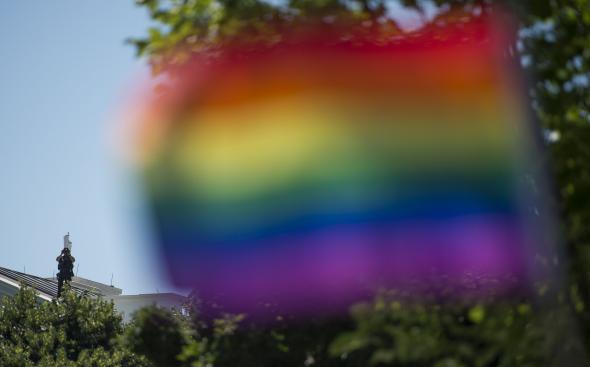Leather and mesh. Pride season always drags these materials from the depths of my otherwise bland closet. I’m not so unlike other people in that way. Pride is a queer Halloween of sorts: A liberating campiness hovers over the whole thing, blurring the line between clothing and costume. The result is an opportunity for earnest self-expression that doesn’t carry the same risks because it’s offset by a sarcastic wink.
But at a strobe-lit party, standing shoulder to sweaty shoulder with bodies that move more gracefully than mine, I’m reminded why I prefer these clothes on other people. I’m wearing a sheer top, like hundreds of others in the room. But I swear the light is hitting me differently, and I swear my love handles are giving me away, and my costume feels more like a disguise. It doesn’t express. It deceives. I wonder if people can see right through me. I wonder if people are taking one look at me and thinking, “Oh, hon.”
That might sound paranoid, but that’s what body dysmorphia is: constant paranoia of being seen. In my mind’s eye, my body is a funhouse distortion, shifting and warping in grotesque ways, and the world around me becomes a wilderness of mirrors. I see other people, whose proportions are fixed and whose angles create definite shapes, and they seem entirely unbothered by having a body. I see them, and I think to myself, what would I do if I could move through life like that?
I never really learned how to comfortably take up space. Living in a fat body for half of my life conditioned me to perceive my presence as an infringement of sorts, one that warranted apology. Pride, a time that encourages us to be more unapologetic than ever, is no exception. In fact, amidst the skin and the sex and the celebrations of physicality, it’s a time when my discomfort with my body is at an all-time high, a yearly progress report on how far I haven’t come.
I wondered if other people shared similar anxieties when Pride season comes around. First, I asked writer Mathew Rodriguez from Mic, a queer Puerto Rican who considers himself a person of size.
“Being in the parade, it’s always hot, and we gays love to cut holes in the sides of our shirt and transform what we’re wearing,” Rodriguez said. “I’ve always felt the need to participate in that in a compulsory way, sort of like, I’m the big girl, but I’m going to cut my shirt too. It’s performative in a way. It can make me feel uncomfortable.”
I immediately identified with that sentiment. As a person with body dysmorphia, I feel uncomfortable at Pride, because I think of Pride as being more for people who know how to take up space. I don’t necessarily mean that in a negative way. The queer body is radical because it asserts itself in a cisgender, heterosexual context that seeks to erase it. We celebrate visibility during Pride because we inhabit a world that would render us invisible, and part of that visibility means putting our bodies on display if we choose to. But how do I celebrate visibility when I don’t want to be seen?
Next, I asked actor Ian Campayno, a gay man who openly admits he conforms to the traditional conventions of attractiveness, for his thoughts on people who express discomfort with their bodies during Pride.
“I work hard at the gym to keep myself in shape and healthy,” Campayno said. “I love Pride season. I think it’s a great reminder to celebrate those that came before us, who fought for us.
“I think everyone gets insecure about their bodies,” he went on. “I think if someone is not happy with their body during Pride, they’re probably not happy with their body year round. My advice would be to take control of your confidence and your self-love. If something is making you unhappy, change it.”
On a personal level, I certainly agree with Campayno that my discomfort with my body isn’t exclusive to Pride season. But I also can’t deny that Pride tends to exacerbate my dysmorphia, or that gay community in particular isn’t proving to be the best environment for people who suffer from body image issues.
Studies have shown that gay men are more likely to suffer from eating disorders and to binge and purge than their heterosexual counterparts. Though gay men are thought to represent 5 percent of the total male population, they represent a staggering 42 percent of men who identify as having an eating disorder.
These statistics tell me that I am likely not alone after all in feeling uncomfortable with my body in gay spaces. But they also tell me that we are not doing an adequate job in having conversations about it. Calling attention to that conversation, I find, is what Pride is all about.
My experiences as a queer person and (formerly) a person of size have taught me parallel lessons. I learned how to create spaces where I could be affirmed and where I could express agency. Pride, despite its problems, is a multi-faceted, diverse experience that exits to assert such a space. It’s as much a struggle as it is a celebration. And if I can’t always see myself in the celebration, I can see myself in the struggle to make room for people who feel pushed to the margins.
“I try to do Pride on my own terms,” Rodriguez said. “I go to places I’m more familiar with. I go to spaces where my body is a little more accepted. You really have to put yourself in a place where you feel powerful.”
